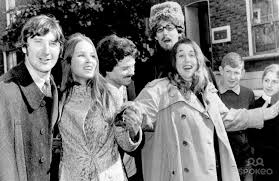Performance is probably the greatest London film of all time. When this strange and unsettling fusion of counterculture and crime was finally released in 1970, it was accompanied by a novelisation – a cheap paperback by William Hughes published by Tandem – that I chanced upon last week behind the counter in the fabulous Bookmongers on Coldharbour Lane. I love novelisations, so this was a no brainer.
Although I’ve read a few books about Performance – the best is Paul Buck’s 2012 biography of the film published by Omnibus, which frustratingly lacks an index – I’m not sure I was aware there had been a novelisation. There’s a short review here, but there’s little about William Hughes on the internet, although his name does crop up on Abe Book alongside some other novelisations of the era – 1968’s Secret Ceremony, 1971’s Lust For A Vampire, 1974’s The Marseille Contract, 1976’s Aces High and 1978’s Death Sport among others. A follower on Twitter suggested his real name was Hugh Williams.
UPDATE Head to the comments for a great twist on the “who was William Hughes” question…

What particularly appealed was the knowledge that novelisations are often written from early drafts of scripts, which means there are interesting differences between the plots as told in the books and what you get in the finished films. I was very keen to see how Performance the book differed from Cammell and Roeg’s final film, and also curious at how the author would tackle some of the stranger moments from the film, including the famous ending. Incidentally, apparently the film’s dialogue coach and underworld/counterculture figure David Litvinoff wanted to write it, but was declined.
The book is, as you’d probably expect, a lot more conventional than the film – but that isn’t saying a great deal, as most things are more conventional than Performance. William Hughes is a decent writer who has a great sense of pace and solid grasp of genre, so he is pretty assured when dealing with the first half of the story – about the gangster Chas who oversteps the mark and has to do a runner. This all unfolds at great speed, but we are also treated to some insights into Chas’s background, motivations and general sense of unease at his chosen career as a heavy. We learn that Chas lives in a “luxury flat in predominantly working class” Shepherds Bush, and his activities take him to various parts of London including Campden (sic) Town, where he terrorises a mini cab firm, Mayfair, Liecester Square (sic) and the Temple, where a lawyer’s chauffer is shaved while his Rolls-Royce is covered in acid.
In the film, things get much weirder when the action moves to the home of a reclusive rock star in West London – in the film this is located at Powis Square but here it’s named as 22 Melbury Terrace, “behind Notting Hill Tube”. Hughes handles that transition fairly well and there’s a sense of Chas’s discomfort as he encounters Turner and his two female friends, Pherber and Lucy. But while in the film this relationship becomes relationship increasingly complex and sinister, the book – presumably following the initial script – has the two worlds quickly come to an understanding. They develop a sense of mutual respect and it all feels far more comfortable than it does on film. There’s also much less sex. Or as one Twitter user put it..
What that suggests is how ordinary a film Performance could have been without Cammell’s influence and without the performances of Edward Fox and Mick Jagger, whose uneasy sparring is one of the signature flavours of the film. Plot-wise, the most notable difference is right at the end, but there are other more subtle plot differences that affect the mood – for instance, at one point in the book we go into the garden at Powis Square/Melbury Terrace, while there’s also a pivotal, and topical, drug bust that never made it into the final film. Both these scenes would have diluted the claustrophobic, hallucinogenic nature of the second section of the film, which has one of the most peculiar atmospheres of any film by a major studio thanks, it seems, to the way Cammell and Anita Pallenberg manipulated Fox and Jagger. Oh, and the book also omits one of the greatest lines in the film: “Comical little geezer. You’ll look funny when you’re fifty.”

These aren’t the only differences. Chas runs to Powis Square/Melbury Terrace because he murders a rival, Joey Maddocks, bringing down unwanted heat on the mob led by Harry Flowers. In the film, there are strong suggestions that Chas and Joey were former lovers and that Chas’s repressed homosexuality is part of the “performance” but in the book this relationship is made explicit. By contrast, Flower’s own homosexuality, alluded to on film, makes no appearance in the book.
Being trivial, I also enjoyed some of the moments of trivia. We learn the name of Turner’s band – Turner And The Spinals, or Turner And The Spinal Cords – and the fact they scored seven No 1s and three No 2s. In fact, “not one of his singles ever missed the charts. Up until the end, I mean”, says his still faithful housekeeper. It turns out that Turner was such a star he shook the Queen’s hand at a film premiere. At one point, Chas even hums one of his hits.
“Of all the crap I ever perpetuated, that was the vilest, man,” says Turner.























